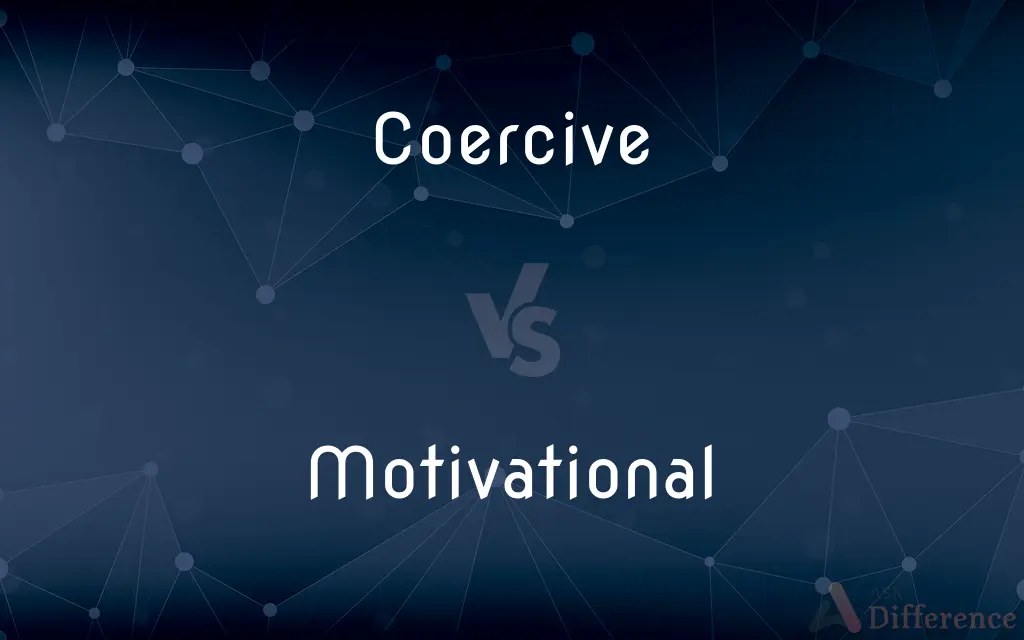Coercive vs. Motivational — What's the Difference?
By Tayyaba Rehman & Fiza Rafique — Updated on March 28, 2024
Coercive methods compel through force or threats, while motivational approaches inspire or encourage positive actions.

Difference Between Coercive and Motivational
Table of Contents
ADVERTISEMENT
Key Differences
Coercive strategies rely on the use of force, threats, or punishment to influence behavior or decisions. This approach is often associated with authoritarian leadership styles, where obedience is demanded and dissent is not tolerated. Whereas motivational strategies aim to inspire and encourage individuals through positive reinforcement, understanding, and the promotion of intrinsic rewards. These methods are linked with more democratic and transformational leadership styles, emphasizing collaboration and personal growth.
In the workplace, coercive tactics may involve threats of demotion, dismissal, or other forms of reprimand to ensure compliance with policies or directives. On the other hand, motivational techniques might include recognition programs, career development opportunities, and the fostering of a positive organizational culture to stimulate engagement and productivity.
While coercive measures can lead to immediate results, they often contribute to a negative atmosphere, characterized by fear and resentment. Conversely, motivational strategies tend to build trust and loyalty, fostering an environment where individuals are more likely to commit to their roles and exceed expectations willingly.
In terms of outcomes, coercion can result in superficial compliance, where individuals conform only in the presence of the coercive force. Motivational approaches, however, are more likely to result in genuine commitment, with individuals adopting desired behaviors or attitudes because they see personal or collective value in doing so.
The choice between coercive and motivational strategies depends on the context and objectives, but the long-term benefits of motivational approaches in fostering a healthy, productive, and innovative environment are well-documented. While coercion might be considered necessary in certain critical or high-stakes situations, reliance on such methods can undermine relationships and morale over time.
ADVERTISEMENT
Comparison Chart
Basis of Influence
Force, threats, punishment.
Inspiration, encouragement, positive reinforcement.
Leadership Style
Authoritarian.
Democratic, transformational.
Typical Environment
Negative atmosphere, fear-based.
Positive atmosphere, trust-based.
Outcomes
Immediate compliance, potential resentment.
Long-term commitment, higher morale.
Application
High-stakes, immediate results needed.
Sustainable growth, engagement, innovation.
Compare with Definitions
Coercive
Based on imposing penalties to enforce rules.
Coercive measures were introduced to curb late arrivals.
Motivational
Focused on encouraging personal and collective growth.
Motivational leadership practices have fostered a culture of innovation.
Coercive
Often results in superficial adherence.
Despite the coercive policies, genuine commitment was lacking.
Motivational
Inspiring individuals to achieve through positive means.
Her motivational speech galvanized the team to exceed their targets.
Coercive
Linked with authoritarian leadership.
The leader's coercive style created a culture of fear.
Motivational
Promotes a positive and engaging work environment.
The manager's motivational approach resulted in high job satisfaction.
Coercive
Employing force or threats to ensure compliance.
The manager's coercive tactics left the team feeling demoralized.
Motivational
Builds commitment through shared values and goals.
Motivational strategies aligned the team's efforts with the organization's mission.
Coercive
Relies on fear to achieve objectives.
The coercive atmosphere stifled creativity and communication.
Motivational
Utilizes rewards and recognition to influence behavior.
The company's motivational incentives boosted morale and productivity.
Coercive
Characterized by or inclined to coercion.
Motivational
The act or process of motivating
The coach's effective motivation of her players.
Coercive
Displaying a tendency or intent to coerce.
Motivational
The state of being motivated; having a desire or willingness to act
Students with a high level of motivation.
Coercive
Such that the ratio of |F(x)| to x approaches infinity as x approaches infinity.
Motivational
Something that motivates; an inducement, reason, or goal
“If your primary motivation in life is to be moral, you don't become an artist” (Mary Gordon).
Coercive
Serving or intended to coerce; having power to constrain.
Coercive power can only influence us to outward practice.
The power of resisting magnetization or demagnization is sometimes called coercive force.
Motivational
Tending or intended to motivate.
Coercive
Serving or intended to coerce;
Authority is directional instead of coercive
Motivational
Of or relating to motivation
Common Curiosities
Why are motivational strategies preferred?
Motivational strategies are preferred because they foster a positive environment, build trust, and lead to genuine commitment.
Can coercive tactics be effective?
Coercive tactics can be effective for immediate compliance but may lead to negative outcomes like resentment in the long term.
How do motivational techniques enhance productivity?
By fostering an engaging and supportive environment, they enhance motivation, satisfaction, and thus, productivity.
How do motivational strategies impact employee retention?
They positively impact retention by building loyalty, satisfaction, and a sense of belonging among employees.
How do motivational approaches work?
Motivational approaches work by inspiring, encouraging, and using positive reinforcement to influence behavior.
Can motivational strategies lead to over-reliance on rewards?
Yes, if not carefully implemented, there can be an over-reliance on rewards, potentially diminishing intrinsic motivation.
What defines a coercive strategy?
A coercive strategy is defined by the use of force, threats, or punishment to influence behavior.
How can a balance be struck between coercive and motivational methods?
A balanced approach requires situational awareness, clear communication, and the ability to adapt leadership styles as needed.
What are the risks of a coercive leadership style?
Risks include a negative atmosphere, decreased morale, stifled creativity, and potential turnover.
Are coercive methods always negative?
While often seen as negative, they might be deemed necessary in critical situations requiring immediate action.
Can a leadership style be both coercive and motivational?
While fundamentally different, some leaders might employ a mix of tactics depending on the situation and objectives.
What role does communication play in motivational strategies?
Effective communication is vital, as it helps clarify goals, recognizes achievements, and fosters a sense of community.
How do cultural differences affect the perception of coercive strategies?
Cultural backgrounds can significantly influence how coercive strategies are perceived, with some cultures more accepting than others.
What are long-term benefits of motivational leadership?
Long-term benefits include sustained high performance, innovation, and a strong, cohesive organizational culture.
Is coercion more effective in certain industries?
Coercion may be viewed as more effective in high-stakes or emergency scenarios where immediate compliance is crucial.
Share Your Discovery

Previous Comparison
Estuary vs. Creek
Next Comparison
Amnesia vs. AlzheimersAuthor Spotlight
Written by
Tayyaba RehmanTayyaba Rehman is a distinguished writer, currently serving as a primary contributor to askdifference.com. As a researcher in semantics and etymology, Tayyaba's passion for the complexity of languages and their distinctions has found a perfect home on the platform. Tayyaba delves into the intricacies of language, distinguishing between commonly confused words and phrases, thereby providing clarity for readers worldwide.
Co-written by
Fiza RafiqueFiza Rafique is a skilled content writer at AskDifference.com, where she meticulously refines and enhances written pieces. Drawing from her vast editorial expertise, Fiza ensures clarity, accuracy, and precision in every article. Passionate about language, she continually seeks to elevate the quality of content for readers worldwide.














































